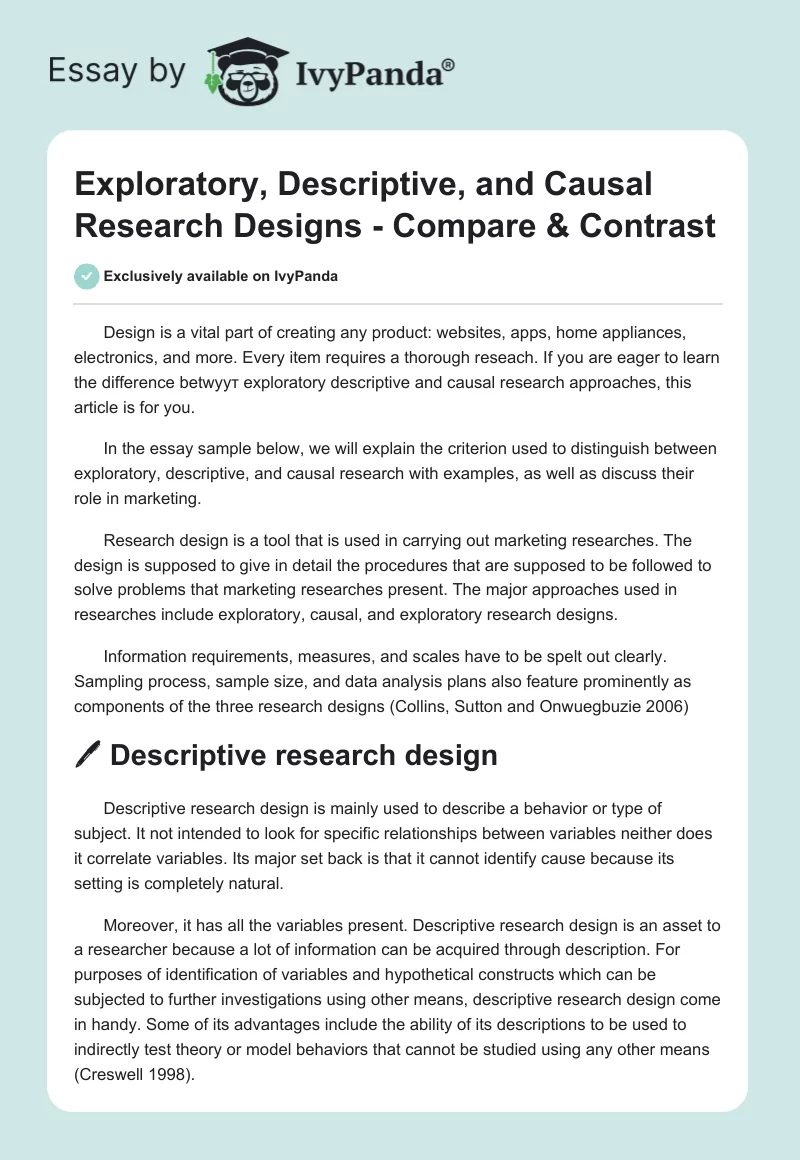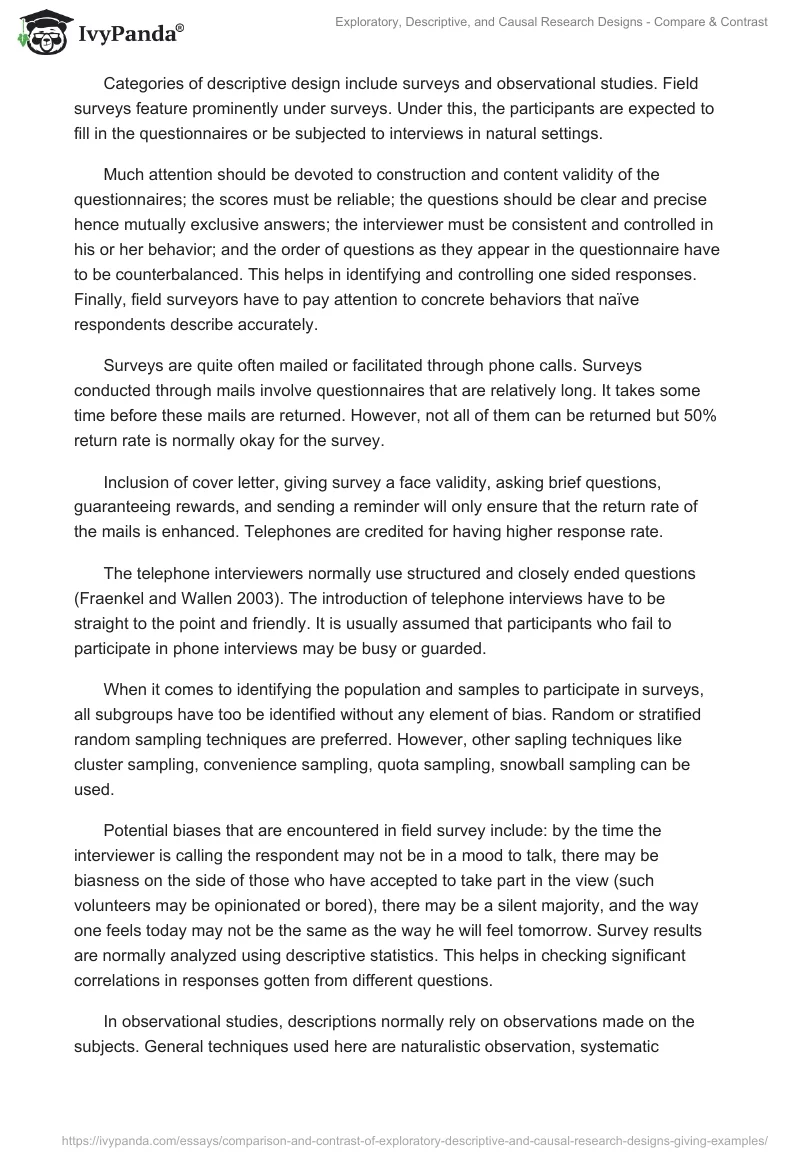Design is a vital part of creating any product: websites, apps, home appliances, electronics, and more. Every item requires thorough research. If you are eager to learn the difference between exploratory descriptive and causal research approaches, this article is for you.
In the essay sample below, we will explain the criterion used to distinguish between exploratory, descriptive, and causal research with examples and discuss their role in marketing.
Research design is a tool that is used in carrying out marketing researches. The design is supposed to give in detail the procedures that are supposed to be followed to solve problems that marketing researches present. The major approaches used in researches include exploratory, causal, and exploratory research designs.
Information requirements, measures, and scales have to be spelled out clearly. The sampling process, sample size, and data analysis plans also feature prominently as components of the three research designs (Collins, Sutton, and Onwuegbuzie 2006)
🖊️ Descriptive research design
Descriptive research design is mainly used to describe a behavior or type of subject. It is not intended to look for specific relationships between variables, nor does it correlate with variables. Its major setback is that it cannot identify the cause because its setting is completely natural.
Moreover, it has all the variables present. Descriptive research design is an asset to a researcher because a lot of information can be acquired through description. For purposes of identification of variables and hypothetical constructs which can be subjected to further investigations using other means, descriptive research design comes in handy. Some of its advantages include the ability of its descriptions to be used to indirectly test theory or model behaviors that cannot be studied using any other means (Creswell 1998).
Categories of descriptive design include surveys and observational studies. Field surveys feature prominently under surveys. Under this, the participants are expected to fill in the questionnaires or be subjected to interviews in natural settings.
Much attention should be devoted to the construction and content validity of the questionnaires; the scores must be reliable; the questions should be clear and precise hence mutually exclusive answers; the interviewer must be consistent and controlled in his or her behavior; and the order of questions, as they appear in the questionnaire, have to be counterbalanced. This helps in identifying and controlling one-sided responses. Finally, field surveyors have to pay attention to concrete behaviors that naïve respondents describe accurately.
Surveys are quite often mailed or facilitated through phone calls. Surveys conducted through mail involve questionnaires that are relatively long. It takes some time before these emails are returned. However, not all of them can be returned, but a 50% return rate is normally okay for the survey.
The inclusion of a cover letter, giving the survey face validity, asking brief questions, guaranteeing rewards, and sending a reminder will only ensure that the return rate of the mail is enhanced. Telephones are credited for having a higher response rate.
Telephone interviewers normally use structured and closely-ended questions (Fraenkel and Wallen 2003). The introduction of telephone interviews has to be straight to the point and friendly. It is usually assumed that participants who fail to participate in phone interviews may be busy or guarded.
When it comes to identifying the population and samples to participate in surveys, all subgroups have to be identified without any element of bias. Random or stratified random sampling techniques are preferred. However, other sapling techniques like cluster sampling, convenience sampling, quota sampling, and snowball sampling can be used.
Potential biases that are encountered in field surveys include:
- By the time the interviewer is calling, the respondent may not be in the mood to talk,
- There may be biasness on the side of those who have accepted to take part in the view (such volunteers may be opinionated or bored),
- There may be the silent majority,
- The way one feels today may not be the same as the way he will feel tomorrow.
Survey results are normally analyzed using descriptive statistics. This helps in checking significant correlations in responses obtained from different questions.
In observational studies, descriptions normally rely on observations made on the subjects. The general techniques used here are naturalistic observation, systematic naturalistic observation, and participant observation. Naturalistic observation is unstructured and unsystematic.
It entails observation of a wide range of behaviors. Systematic naturalistic observation is systematic and looks into specific behaviors. Participant observation requires that the investigator infiltrate the group he or she is observing. The observer acts like a spy agent whose true identity and purpose cannot be known (Creswell 2005).
The major advantage of observation studies is that it is absolutely natural. It does not, therefore, demand characteristics. Its disadvantages are the unavailability of informed consent. It relies on convenience samples, and the data used is mostly qualitative, as there are much of verbal descriptions and observations made visually.
Observation studies are supposed to help in identifying variables that are valuable in indirect tests of models and predictions. In order to decrease bias in observation studies, well-defined scoring criteria have to be developed, a time sampling technique must be used, there have to be multiple observers, double-blind procedures have to be used, and for the purpose of increasing external validity, it is imperative that random samples are obtained.
🔍 Exploratory research design
Exploratory research design is normally used in research whose purpose involves inquiry into new products that should be developed, how the product appeal will enhance its advertising, and how the existing services can be improved.
Research questions in exploratory research design border on the alternative ways that exist that can be used, for example, to provide lunch for school children, the kind of benefits people stand to get from the product, and the nature of dissatisfaction the customer may be getting from the product in the case of marketing research. The hypothesis here has unknown constructs. The hypothesis also suspects that the major problem in the study could be impersonalization.
🔥 Causal research design
The purpose of this research design from a marketing research perspective is to ascertain whether an increase in the service staff can be profitable, which advertising program for public transit is suitable, and whether a new budget should be contemplated. The research questions here touch on the correlation between the size of staff offering services and the revenue that is accrued. What do people stand to get from cars and public transport?
⚖️ Comparison of the three research designs
The major objective of exploratory research design is to discover ideas and insights, whereas descriptive research design involves describing market aspects and functions. Nevertheless, causal research design tries to determine the cause-effect relationships in the research one is conducting.
A major feature of exploratory design is its flexibility, its adaptability, and the front end of total research design. However, descriptive research design is marked by past formulation of specific hypotheses from observations and studies. This design is pre-planned and structured. A causal research approach can proceed through one or more independent variables. Other mediating variables that fall under this design can also be controlled.
An exploratory research approach entails the use of surveys, case studies, information from other studies, and qualitative analyses. In contrast, a descriptive research approach uses information from other studies, panels, analyses, and observations. Causal research design strictly uses experiments.
🔗 References List
Collins, K. M. T., Onwuegbuzie, A. J., & Sutton, I. L., 2006, A model incorporating the rationale and purpose for conducting mixed methods research in special education and beyond, Learning Disabilities: A Contemporary Journal, vol.4, pp. 67-100.
Creswell, J. W., 1998, Qualitative inquiry and research design: Choosing among the five traditions. Thousand Oaks, CA: Sage.
Creswell, J. W., 2005, Educational research: Planning, conducting, and evaluating quantitative and qualitative research (2nd ed.). Upper Saddle River, NJ: Pearson Education.
Fraenkel, J. R., & Wallen, N. E., 2003, How to design and evaluate research in education (5th ed.). Boston: McGraw-Hill.
⁉️ FAQ
Is causal research and explanatory research the same?
Despite causal research can sometimes be referred to as explanatory research, there is a difference. Causal research is an evaluation of whether two different aspects have cause-and-effect relationships. The explanatory research goal is to determine the exact nature of the issue to be solved.
What is exploratory descriptive and causal research?
An exploratory research method uses case studies, surveys, qualitative analyses, and information from other studies. A descriptive research approach entails using information from other studies, analyses, panels, and observations. In contrast, causal research design uses experiments.
What are the 3 types of research?
Most research approaches can be divided into 3 types: descriptive, causal, and exploratory. Depending on the end purpose, a researcher should use the exact methods and instruments.


